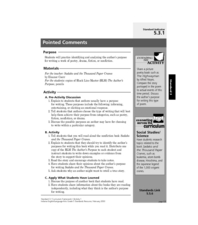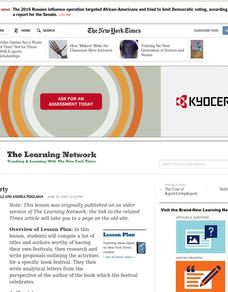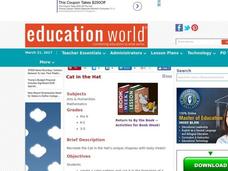College Board
Engaging the Intuition in Statistics to Motivate
Motivation is key to learning. The author points out that it is important to engage intuition for aspects of statistics that pupils find counter-intuitive. Three strategies—using multiple representations, using intuitive analogies, and...
EngageNY
Analyzing the Central Claim and Supporting Claims: “The Shakespeare Shakedown”
Scholars continue to analyze Simon Schama's article "The Shakespeare Shakedown." They participate in a jigsaw discussion to identify the author's argument and supporting claims. Pupils also write objective summaries of the text.
State Library of Ohio
All the Light We Cannot See Toolkit
Anthony Doerr's Pulitzer Prize-winning novel All the Light We Cannot See is the focus of a toolkit that provides readers with a summary of the plot, background information about the author, and discussion topics.
Curated OER
Pick Your Favorite Author
Students use the Internet to access information about their favorite author after reading a book by the author. They write a brief summary about the author.
Curated OER
Pointed Comments
Fifth graders analyze pieces of writing to identify the author's purpose of writing. In this writing lesson, 5th graders consider a variety of pieces of writing such as, poetry, drama, fiction, and non-fiction. Each student completes an...
Curated OER
Jason's Gold: Chapter 9
Students collect details from chapter 9 of the book Jason's Gold and connect them back to the author's purpose of the book. For this details lesson plan, students listen to a read aloud where they discuss the details with the teacher as...
Curated OER
Book Party
Pupils compile a list of titles and authors worthy of having their own festivals, then research and write proposals outlining the activities for a specific book festival. They write analytical letters from the perspective of the author...
Curated OER
Reader's Theater, Get Ready
Students recognize what features make a play. In this reader's theater lesson plan, students read the play Master Man: A Tall Tale of Nigeria told by Aaron Shepard and determine what features make this a play and what the author's...
Curated OER
Joseph Had a Little Overcoat Lesson Plan
Students discuss various features of a book, aspects of the story, and then engage in a retelling of the story. In this early childhood lesson plan, students identify the author, illustrator, and title of a book, Joseph Had a Little...
Curated OER
Looking Inside a Textbook
Learners practice newly acquired knowledge by working in pairs or is small group to answer questions in a practice sheet. They become familiar with the terminology used to identify textbooks. Pupils give the definition of: Textbook,...
Curated OER
Who is Dr. Seuss?
Learn more about Dr. Seuss in an author study activity. After young readers create a KWL chart on information they know about Dr. Seuss, they take on group roles, such as the researcher or recorder, to find out more about Dr. Seuss. They...
Curated OER
Fiction vs. Nonfiction
Young scholars explore fiction and nonfiction writing. They identify the elements of fiction in a short story and identify the criteria necessary in a nonfiction piece. Students distinguish the author's purpose in an expository text,...
Curated OER
Winner's Never Quit: comprehension skills
In this comprehension skills worksheet, students read the book Winner's Never Quit and complete comprehension skills such as predicting, summarizing, making inferences, and author's purpose. Students complete 5 activities.
Curated OER
Watching in the Wild: comprehension skills
In this Comprehension skills worksheet, students read the book Watching in the Wild and complete comprehension activities. Students complete 3 main idea and details sheets, summarizing, and author's purpose.
Curated OER
Story Elements
In this story elements worksheet, students examine 20 things listed in a chart. They write the correct number inside each box to indicate what type of story element it is: the title, the author, the characters, or the setting
Curated OER
Use of Symbolism to Convey the Author's Message - The Negro Speaks of Rivers
Students identify the literary devices, symbolism, and first-person narration in the poem A Negro Speaks of Rivers. For this poem analysis lesson, students discuss African Americans and the Harlem Renaissance. Students watch a video...
Curated OER
General Knowledge of Books #66
In this general knowledge of books #66 activity, students interactively answer 10 questions about British and American books and authors with immediate online feedback.
Curated OER
Lesson 2: Identifying an Author's Purpose (part 2)
Keep reinforcing the concept of author's purpose with a practice activity. After discussing the three purposes of writing, third graders will complete a graphic organizer intended to help them pin point textual evidence that proves...
Penguin Books
Teacher’s Guide: Of Mice and Men by John Steinbeck
A 10-page guide to John Steinbeck's Of Mice and Men includes a brief plot summary, information about preparing readers for the language in the novel, pre-reading, during reading, and post-reading questions, essay prompts, and project...
Syracuse City School District
Reading Comprehension Unit Plan
A unit plan uses short texts to teach literary elements such as theme and characterization. Included are passages by authors such as Walter Dean Myers and Sandra Cisneros. Activities include quick writes, filling in graphic organizers,...
Curated OER
Chain Together A Book Report
Individuals examine a book's components, including key events, characters, and vocabulary and develop "chain book reports" with their peers. Strips of paper containing the book's important events are staples together and hung.
Curated OER
Kudos by Kiddos
Students explore types of awards for children's books. They design a new award. Students review books and select one to receive the newly designed award. Students create a "medal" for the book jacket. They write an explanation of the award.
Curated OER
Cat in the Hat
Explore the book The Cat in the Hat by Dr. Seuss with your class. They will design a pattern for the cat's hat. They will create color pattern designs with candy and frosting. In the end, they will describe their pattern.
Curated OER
Evaluating Accuracy and Adequacy
Evaluate non-fiction works with your English class. While practicing a variety of strategies detailed in the plan, readers compare and contrast the information in three non-fiction passages about the same topic. They then discuss the...
Other popular searches
- Authors Purpose
- Author's Purpose
- Author Study
- Authors Point of View
- Authors Purpose Powerpoint
- Authors Purpose Mini Lesson
- Author Research
- Authors Purpose Passage
- Georgia Authors
- Authors Study
- Teaching Author's Purpose
- Student Authors

























